Regional Cakeathon B: Bath Buns |
Story location: Home / food_and_drink / a_to_z / |
| 19/Jan/2014 |
We used to occasionally go to a Hamster Show just on the edge of Bath. I would take the bus down into the city centre to explore and do a bit of shopping. One time I went around the Cathedral, another time I walked along the river. There are a few things I would always do though: I would go to the fudge shop and buy a few bars, then to the market where I bought a couple of cakes from one stall and some loose tea from another.
I don't remember ever buying a Bath Bun so I can't compare mine to the ones sold in the city but I don't think that will be too much of a problem since the recipe has changed over the years and there are several different versions of the recipe around today.
There is a bit of controversy over the origin of the Bath Buns, with some people claiming they were invented by a physician while the Sally Lunn tea shop people claim their eponymous buns are the originals and were brought over from France by Sally herself. This has been called into dispute though, with claims that Sally Lunn is a corruption of the French 'Soleil et Lune', or Sun and Moon.
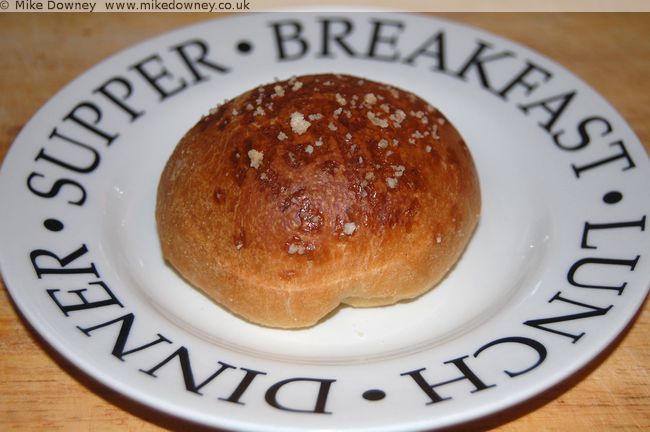
While looking for recipe suggestions, I encountered a few vintage recipes such as the one in The Art of Cookery made Easy and Refined by John Mollard and published in 1802. This used equal amounts of flour and butter and would probably result in quite a rich bun.

A version of the recipe published in Cassell's Dictionary of Cookery in 1894 is similar to a modern version published in the Daily Telegraph but with the addition of 4 eggs, which would result in quite a rich cake too.
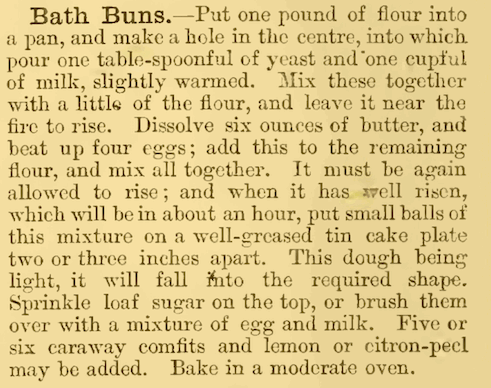
I decided to concoct a version roughly halfway between Cassell and the Telegraph but also to make only half the quantities since enriched breads don't always keep very well and can dry out quickly. Various recipes mention caraway comfits so I attempted to do something similar and make some sugar coated seeds.
Recipe
- 250g Flour
- 100ml Milk
- 2 Medium Eggs
- 75g Butter
- 1 tsp salt
- 1 tbs sugar
- 1 tsp yeast
Put the flour, salt and butter in a food processor, add the sugar and a few caraway seeds then process in pulse mode to form breadcrumbs.
Pour into a mixing bowl and add the yeast. Beat the eggs and milk together and add to the bowl. Mix to form a dough, knead for 5-10 minutes (depending on how long you can tolerate handling a rich sticky dough) and leave to rise until doubled in size. Knock back and shape the dough into 6 equal sized balls. Place these on a floured baking tray.
Brush the buns with milk and sprinkle with sugar nibs or the sugared caraway seeds. Leave the buns to rise again then bake at gas mark 5 for 15-20 minutes.
Sugared Caraway Seeds
Put 5 heaped tablespoons of sugar in a pan, adding just enough water to get it to dissolve (about 2 tbs or so) and heat it gently. Add 1 heaped tablespoon of caraway seeds and continue heating while stirring occasionally. After several minutes, the thick syrup will rapidly change from liquid to crystals. Take the pan off the heat and pour the sugared seeds onto a sheet of baking paper to cool.
When I did this, it came out more like a mixture of large crystals and some seeds with sugar attached.
Semolina Pudding and some recipe updates |
Story location: Home / food_and_drink / |
| 19/Jan/2014 |
I bought some semolina flour a few weeks ago when I saw a bag on offer in the supermarket. I originally bought it because I had read a few recipes which used it in combination with plain flour but the bag remained unopened until recently when I started using it instead of cornmeal to coat loaves or when rolling out pizzas.
Once I had opened it I intended to try a semolina pudding. I can't remember when I last ate this but back in primary school it was occasionally offered as a hot pudding with tinned prunes.
I started looking up recipes then found that a friend of ours had beaten me to it and had already blogged about it.
Since my 'new thing' is microwave porridge (more of that later) I tried making semolina in the microwave. I took 2 cups of milk, whisked in ⅓ cup of semolina, a couple of tablespoons of sugar and a splash of vanilla essence. I cooked it at full power for about 5 minutes, stirring regularly. I stirred in a tablespoon of jam to give a marbled effect. Since this makes quite a lot, there's no way I could eat that quantity all at once so I ate some while it was still hot then put the rest in a tub to set.
Getting back to the microwave porridge, since I don't like having to stand in front of the microwave making sure something doesn't boil over, I have started cooking the porridge on medium for 6 minutes. At this setting I can go away and do something else and it will cook on its own, without needing stirring.
Rustic Spanish Bread revisited
I have been baking a lot of bread recently and have been getting through a bag of bread flour in a week, when previously a bag would last for a month or more. My latest loaf was a sourdough version of the Rustic Spanish Bread I made last week. The starter was made using sourdough but the main dough used regular yeast, following their recipe.
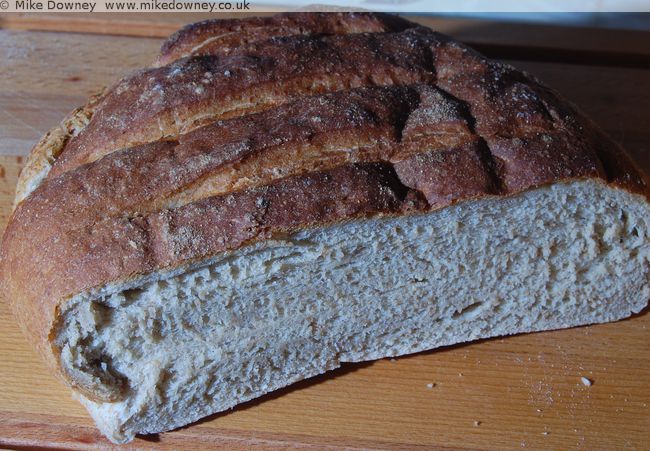
Roast Salsify
I first grew salsify a couple of years ago. The roots were quite small and by the time I had peeled them there wasn't much left to cook. The ones I planted last year did better but I only got around to harvesting them a couple of days ago.
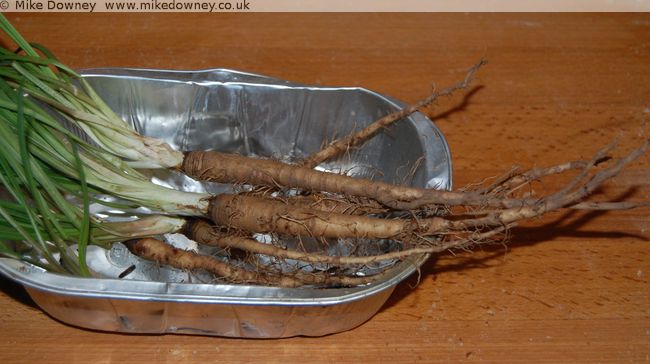
After peeling the roots, I tossed them in olive oil and lemon juice then sprinkled them with sea salt and freshly ground black pepper. They were roasted at gas mark 6 for about 20 minutes. The thick ends came out ok but the tapered ends were a bit over-cooked and had blackened.
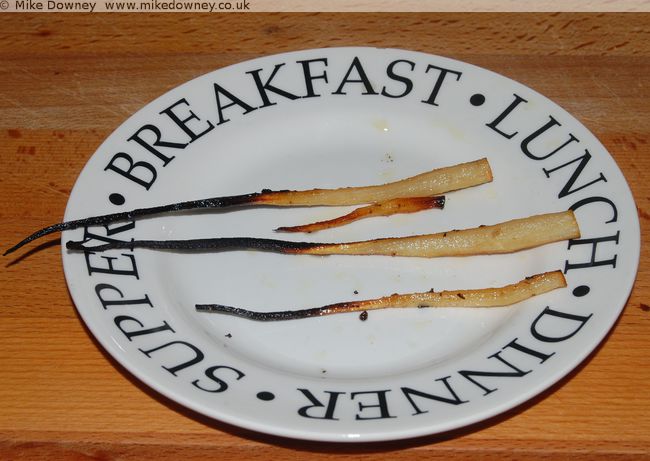
The flavour was quite mild and there was only enough for a snack but I'll probably have another go at growing them this year.
More Hairy Biker Breads |
Story location: Home / food_and_drink / |
| 15/Jan/2014 |
Even though I have challenged myself to baking different 'Regional Cakes', I am still going to be trying various other new recipes including different breads. In the last week I have made two breads based on recipes in the Hairy Biker's Big Book of Baking.
The first was the 'Rustic Spanish Loaf'. I think this may be the first time I have made a loaf using an overnight starter with baking yeast, instead of sourdough wild yeasts. The resulting bread had a soft texture and a crumpet-like flavour.
The second was the 'Breakfast Bread' from the Austrian section of the book. This was an enriched dough with eggs, milk and oil, but was easier to handle than the brioche dough I made last year.
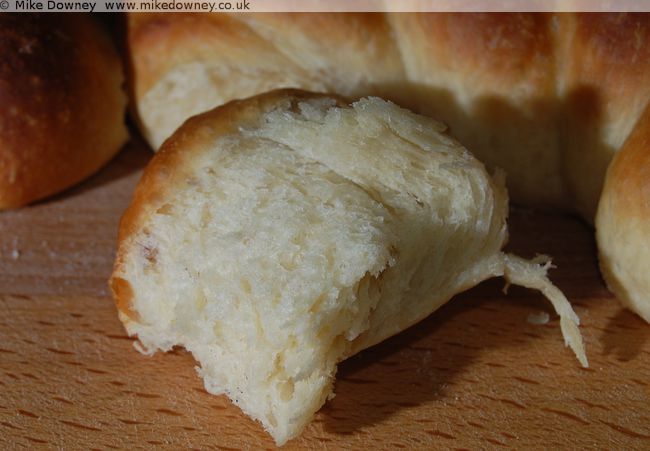
The bread was good and surprisingly quick to make. I left it to prove while we went to the shops and it had risen well by the time we got back.
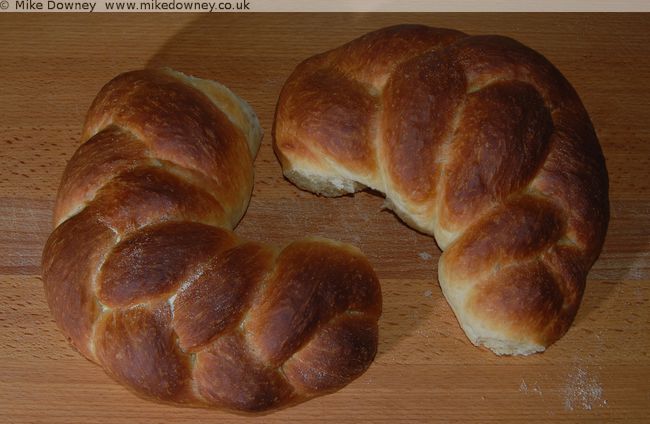
The flavour wasn't as rich as brioche but it did have fewer eggs and didn't contain butter. It might be worth trying again but with a mixture of butter and oil to see what difference that makes.
Macaroni Cheese |
Story location: Home / Blog / food_and_drink / |
| 08/Jan/2014 |
Although I prefer to cook most meals more or less from scratch, I do sometimes like the occasional bit of convenience food. We sometimes have packets of flavoured noodles or the macaroni cheese `Pasta-n-Sauce' and various supermarket brands and copies. We usually add extra vegetables and a meat, such as chicken, tuna or prawns, otherwise they aren't big enough for a meal for two.
The Kraft `Mac and Cheese' is often mentioned in American TV programmes so when I was in Chicago 3 years ago (my God is it really that long ago, time has flown!) I bought a packet to bring home to try.
The British macaroni cheese packets are straightforward to cook: the entire pack of pasta and sauce powder is added to a pan of milk and water and boiled until done.
The American version comes in a box with two packets inside. The larger pack contains the pasta which needs to be cooked separately. The smaller pack is the sauce powder. The cooked pasta is drained and then mixed with butter, milk and the packet of sauce mix.
The British version is smaller but makes more sauce with more flavour. The American version ends up with a pan of pasta with practically no sauce, the milk seems to just get absorbed into the pasta leaving a thin coating. The end result is much less satisfying than a bowl of pasta in a cheese-like sauce.
I recently bought a box of `Tropical Sun' macaroni cheese, which is cooked in the same was as the Kraft mac and cheese. It was also similar to the Kraft stuff in that it was disappointing with very little sauce and was fairly tasteless.
A bowl of proper home made macaroni cheese is much better than any of the above. It's very easy to make but takes a bit longer and is a bit more effort. The hardest part of the job is to grate the cheese. Making the roux is easy, whisking in the milk is easy, adding the cheese is easy. The only real disadvantage of making it properly is the extra washing up it generates.
Regional Cakeathon A: Aberffraw Biscuits |
Story location: Home / food_and_drink / a_to_z / |
| 03/Jan/2014 |
This year my new recipe challenge is to make a regional cake or dessert for each letter of the alphabet. I will be concentrating on British places, with emphasis on places I have visited or which have any particular significance for me. Ideally each dish should come from (or at least be named after) the place in question.
My A to Z of cakes starts in Anglesey. When I was younger we used to have family holidays on Anglesey and we visited Aberffraw on several occasions. I remember swimming upstream in the river but staying in the same place due to the strong current, walking along the sand dunes and visiting the old church on the island just around the coast.
The Aberffraw Biscuit is similar to shortbread and is allegedly the oldest biscuit recipe in Britain. It is traditionally shaped in a scallop shell. I don't have any of those so I used a madeleine tray instead.
The recipe is fairly simple, consisting of just flour, butter and sugar. I used my food processor to cream together 100g of butter and 50g of caster sugar. I added 150g of sifted plain flour, a bit at a time, and pulsed the food processor until everything was mixed together. I had to tip it onto the work surface squash it all together to make a ball.
I broke off small pieces and pushed them into the individual hollows in the madeleine tray before baking the biscuits at gas mark 4 for about 15-20 minutes.
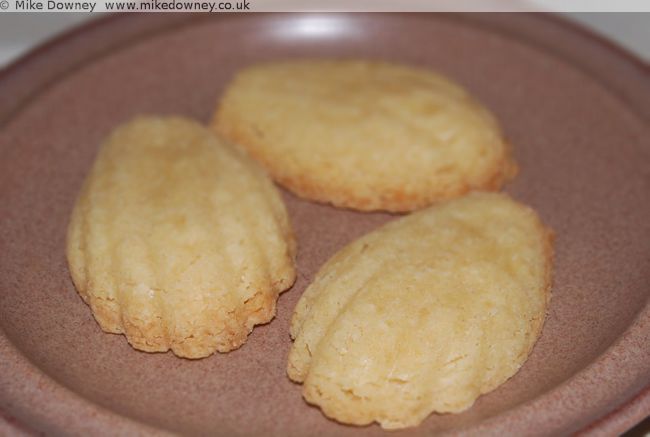
I tried one when they were still warm and the texture was quite soft and almost cakey, quite unlike a shortbread. When they cooled they became firmer but still didn't go as hard as a traditional scottish shortbread. This was a nice simple recipe to start the year but I'll be getting more ambitious with future desserts.
Recipe a week for 2013 |
Story location: Home / food_and_drink / |
| 01/Jan/2014 |
